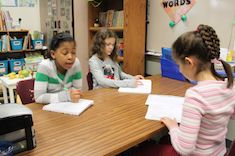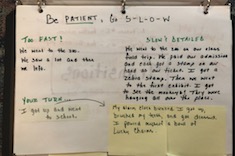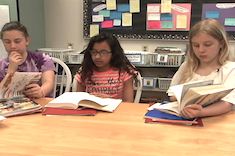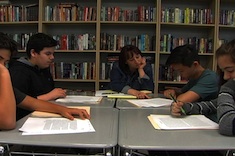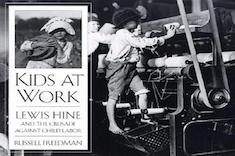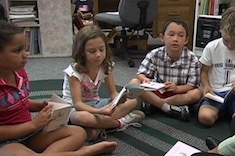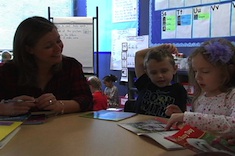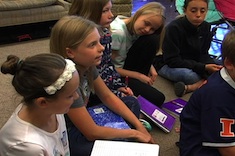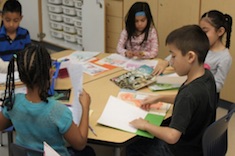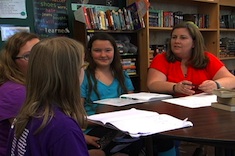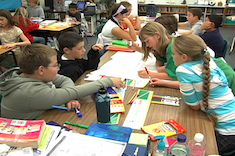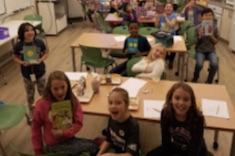Guiding Groups
How many? How often? How to assess? What's the teacher's role? We share flexible and creating strategies for leading groups, and teaching students how to partner and work well with classmates independently. Resources include everything from planning and assessment forms to scores of video examples of groups in action at many grade levels.
Latest Content
Literary Salons: Book Clubs, Elevated
Inspired by the 17th-century popularity of literary salons, Gretchen Schroeder changed the usual book club routine for her high school students. Literary salons allow people to explore big topics and ideas together without reading the same book. They can create engaging discussions, expose students to new ideas and books, and give them the chance to learn from one another in a relaxed way.
Small-Group Instruction: Bookmaking
Brian Sepe shares one of his favorite activities for small groups of young learners: making books together.
Changing How I Teach Small Groups
Tammy Mulligan listens to students and adapts her small-group instruction as they share how they learn.
Fostering Cultural Awareness Through Book Clubs
Gretchen Schroeder’s students are almost all white and live in a rural community. She finds book clubs are a wonderful tool for expanding cultural awareness.
Building Online Writing Groups
Leigh Anne Eck lists critical questions teachers might ask themselves as they build online writing communities where everyone is comfortable giving and receiving feedback.
Balancing Conferences and Small Groups
Balancing small groups and conferences is essential for transferring learning from lessons and units, and it’s one of the trickiest tasks for teachers. Dana Murphy explains how she works toward balance in her classroom, weighing everything from the timeline of the unit to the intensity of the minilesson.
Building Conversation Skills in Book Clubs
Fifth graders use a visual tool to help them build on each other’s ideas in book clubs. They are applying a strategy demonstrated in an earlier minilesson taught by Dana Murphy.
Minilesson: Building Conversations in Book Clubs
Dana Murphy leads a minilesson on book club conversations, using a fishbowl strategy and building blocks to support more sophisticated discussions.
Teaching Conventions in Small Groups
Dana Murphy finds it is best to teach conventions in small, targeted groups in her fifth-grade classroom. She explains how she designs and leads these groups.
The Power of Video Replay
Heather Fisher explains how viewing excerpts from the same video multiple times can help students in book clubs hone their conversation and reflection skills.
Book Club Tools
Tammy Mulligan shares the importance of giving students choice and agency with book club tools to improve engagement and the quality of the conversations.
Guided Reading for Proficient Readers?
Shari Frost is surprised to see guided reading used for proficient fifth-grade readers. She considers some strategic alternatives.
Using a Strategy Notebook in Small-Group Instruction
So many needs for groups, and so little time. Dana Murphy finds that a strategy notebook is invaluable as a teaching aid in her fifth-grade small groups.
Releasing the Teaching to Students
Mark Levine releases responsibility for teaching and assessment to students late in the school year, and hears echoes of learning from previous units.
Forming Groups Using a Planner
Dana Murphy explains how her small-group planner is an essential tool for organizing groups in her fourth-grade classroom.
Getting Started with Strategy Lessons
Tara Barnett and Kate Mills describe how they help teachers move from guided reading to strategy groups in the upper elementary grades.
Small Group: Creativity
Franki Sibberson pulls together a group of fifth graders to explore writing mentors together.
Linking Evidence to Reading Response in First Grade
Tara Barnett and Kate Mills are discouraged by the random and idiosyncratic responses to reading they are seeing among first graders. They implement a series of lessons to help students move to evidence-based reading responses.
Reading The Crossover: Fourth-Grade Reading Group
Gigi McAllister leads a group of boys who are just starting the novel in verse The Crossover in her fourth-grade classroom.
Evidence Claims in a Middle School Small Group
Christy Ruth-Levine leads a small group of eighth graders as they explore how to include textual evidence in their literary analysis essays.
Russell Freedman Book Clubs
Mark Levine finds Russell Freedman book clubs are a great way for his middle school students to deepen their understanding of history and empathize with young people who have lived through previous eras.
Guided Reading Run Amok
Shari Frost helps a teacher who has guided reading groups that have run amok, and discovers that the real culprit is a lack of time for reading and writing in the literacy block.
Enticing Young Readers: First-Grade Group
Bitsy Parks helps a small group of first graders engage with the library early in the year by introducing a series with companion stuffed animals.
Using a Storyboard for Reflection and Comprehension
Christy Rush-Levine shows a group of three students how they can use a storyboard to help track thinking while reading.
Group Meeting: Sharing Resources for Animal Study
Katherine Sokolowski helps her fifth-grade students expand their territory for their animal research projects by sharing information sources and peer connections.
Goals in Small Groups for English Language Learners
Setting small-group goals can be tricky, and the complexity is compounded when you are working with English language learners. Kate Mills explains her goal-setting process with K-3 ELLs, and gives examples of how it works.
Girls’ Book Share in Fifth Grade
Katherine Sokolowski demonstrates how she helps a group of girls in her fifth-grade classroom learn to help each other select books based on previous experiences and tastes.
Gradual Release of Responsibility in Small Groups
Tara Barnett and Kate Mills develop a process of pre-assessment, careful planning, and systematic recordkeeping to up the value of their small groups.
Better Student-Led Literature Discussions
Gigi McAllister tries student-led discussion groups in her fourth-grade classroom, with disastrous results. She regroups the following year with multiple lessons, anchor charts, and preparation to ensure success.
Lunchtime Author Discussion Groups
Gigl McAllister explains why she hosts optional lunchtime author studies, with practical tips on getting started.
Browse Content By
Type
Category
- Assessment Tools
- Big Fresh Archives
- Booklists
- Choice Numeracy
- Classroom Design
- Common Core
- Community Building
- Conferring
- Content Literacy
- Digital Literacy
- English Language Learners
- Equity
- Family Relations
- Free Samples
- Guiding Groups
- Leadership
- Literacy Coaches
- Mentor Texts
- Minilessons
- New Teacher Mentors
- Podcasts
- Poetry
- Quote Collections
- Reading Strategies
- Self Care
- Struggling and Striving Learners
- Talking and Listening
- Teacher Study Groups
- Teaching Reading
- Teaching Writing
- Word Study and Vocabulary
Author
- Melissa Quimby
- Nawal Qarooni
- Gwen Blumberg
- Julie Cox
- The Lead Learners
- Hannah Tills
- Josie Stewart
- Ruth Metcalfe
- Mallory Messenger
- Becca Burk
- Jodie Bailey
- Vivian Chen
- Mary Brower
- Tiffany Abbott Fuller
- Stephanie Affinito
- Ruth Ayres
- Leigh Anne Eck
- Heather Fisher
- Shari Frost
- Julie Johnson
- Suzy Kaback
- Gigi McAllister
- Shirl McPhillips
- Melanie Meehan
- Cathy Mere
- Debbie Miller
- Tara Barnett and Kate Mills
- Tammy Mulligan
- Dana Murphy
- Bitsy Parks
- David Pittman
- Brenda Power
- Heather Rader
- Matt Renwick
- Mandy Robek
- Christy Rush-Levine
- Gretchen Schroeder
- Jen Schwanke
- Brian Sepe
- Katherine Sokolowski
- Stella Villalba
- Jennifer Vincent
Grade Level
Choice Literacy Membership
Articles
Get full access to all Choice Literacy article content
Videos
Get full access to all Choice Literacy video content
Courses
Access Choice Literacy course curriculum and training












